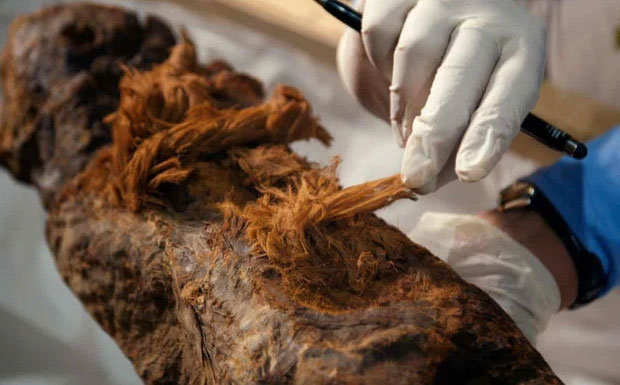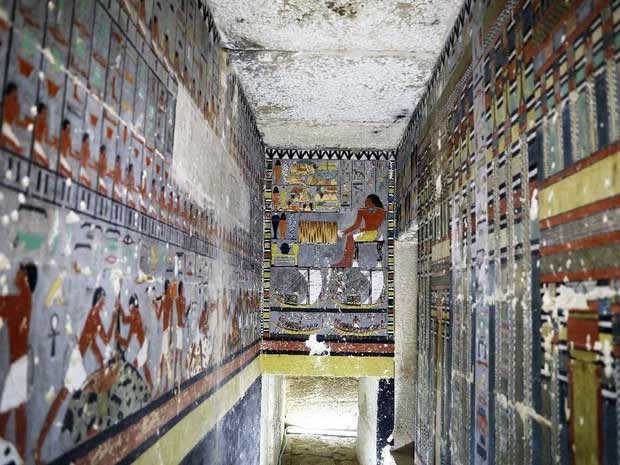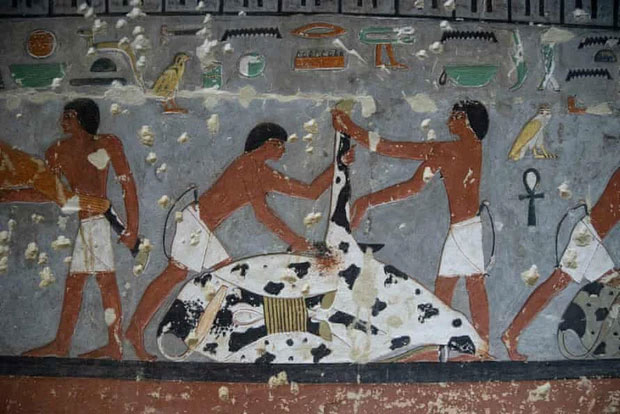The latest archaeological discoveries by scientists reveal that ancient Egyptians practiced mummification over 1,000 years earlier than previously thought by historians. This recent finding about the mummified remains may lead to a rewriting of historical texts.
This is the evidence!
The Oldest Egyptian Mummy of All Time
Archaeologists unearthed the mummy in the Saqqara necropolis, south of Cairo, in 2019. The hieroglyphics on the walls of the tomb where the deceased was laid to rest indicate that the burial took place during the Fifth Dynasty of the Old Kingdom of Egypt.
The well-preserved mummy belonged to a high-ranking noble named Khuwy.
Although discovered in 2019, it wasn’t until now that researchers, using carbon-14 dating techniques, confirmed that the Khuwy mummy is over 4,000 years old and is one of the oldest Egyptian mummies ever found.
The Khuwy mummy dates back to the Old Kingdom of Egypt (circa 2686 to 2181 BC), proving that the mummification techniques of ancient Egyptians existed over 4,000 years ago—1,000 years earlier than modern scientists had previously estimated.

A scientist examines the Khuwy mummy. (Photo: Ian Glatt / National Geographic / Windfall Films).
The sophistication of the mummification process and the materials used—including exceptionally fine linen and high-quality resin—were not believed to have been achieved until 1,000 years later (around 3,000 years ago). This represents a “misjudgment” by previous scientists, as the “perfect” Khuwy mummy has proven otherwise.
Professor Salima Ikram, Chair of Egyptology at the American University in Cairo and a leading expert on mummification history, told Observer/Guardian that: “If this truly is a mummy from the Old Kingdom of Egypt, all books on mummification and the history of the Old Kingdom will have to be rewritten!”
The professor added: “This will completely change our understanding of the development of mummification techniques. The materials used, their origins, and the trade routes related to them will significantly impact our understanding of the Old Kingdom of Egypt.”

The lavishly decorated tomb over 4,000 years ago. (Photo: Egyptian Ministry of Tourism and Antiquities)
“Until now, we thought that the mummification process during the Old Kingdom of Egypt was relatively simple, with a basic drying method—not always successful—without brain removal, and only occasionally removing internal organs,” Professor Salima Ikram added.
Indeed, the focus was more on the external appearance of the deceased rather than meticulously preserving the internal organs. Furthermore, the use of resin was much more limited in mummies from the Old Kingdom than previously recorded.
In contrast, the fact that this mummy was covered in resin and linen presents a completely different impression of the mummification process of ancient Egyptians. In fact, it resembles mummies found 1,000 years later, scientists noted.
The tomb where the mummy was discovered features magnificent wall paintings, painted with “royal colors”—suggesting that Khuwy may have been related to Pharaoh Djedkare Isesi of the Fifth Dynasty. Additionally, Khuwy could belong to a “royal lineage” with the pharaoh of that time, My Modern Met commented.
The tomb has an L-shaped architecture, especially the entrance to the tunnel commonly seen in pyramids—particularly in the Giza Pyramid—further indicating that Khuwy was a person of high status, CNN reported.
Truly Extraordinary!
Ancient embalmers bathed the bodies in luxurious tree resin to preserve the flesh before wrapping them. This mummy was treated with high-quality resin and wrapped in the finest linen.
Professor Salima Ikram exclaimed: “It’s extraordinary! The only time I’ve seen so many types of high-quality linen was during the 21st Dynasty.”
This is one of the significant discoveries revealed in the National Geographic documentary series titled “Lost Treasures of Egypt”, which began airing on November 7, 2021.
The documentary series is produced by Windfall Films, and the filmmakers followed international archaeologists during the excavation season in Egypt. The discovery of the mummy will be featured in episode 4—titled “Rise of the Mummies”—on November 28.

Wall paintings in the tomb of Khuwy. (Photo: Ian Glatt / National Geographic / Windfall Films)
Professor Salima Ikram will appear in that episode alongside archaeologist Dr. Mohamed Megahed, who commented on the latest archaeological discovery: “If this really is Khuwy, then this 4,000-year-old mummy is a breakthrough in the history of ancient Egypt and humanity as a whole.”
The discovery of the mummy in a lavish tomb in the Saqqara necropolis was filmed in a previous segment of National Geographic. The investigation into its dating and analysis appears in the new series. The hieroglyphics reveal that it belonged to Khuwy, a royal family member who lived over 4,000 years ago.
Tom Cook, producer of the series from Windfall Films, stated: “Archaeologists knew the pottery in the tomb belonged to the Old Kingdom of Egypt but didn’t think that the Khuwy mummy was from that period because it was too well preserved. They didn’t believe that the mummification process at that time was so advanced.“
Thus, the filmmaker’s reaction was one of utter astonishment. From amazement to admiration for the high-level mummification techniques of ancient Egyptians, Tom Cook and the archaeological teams were captivated by the irresistible allure of history.
Carolyn Payne, the senior editor of National Geographic, remarked that what makes this series unique is that it follows a group of different archaeologists throughout a season, leading to a series of astonishing discoveries.
The narrator of the documentary series noted: “With each new excavation of bodies by archaeologists, the story of Egyptian mummies becomes clearer.”


















































